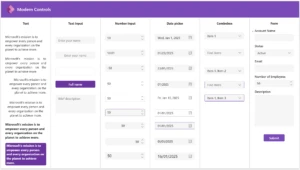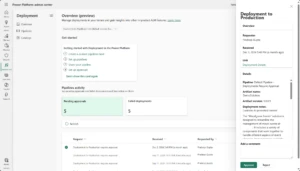
Custom Air Products & Services manages manufacturing process using Microsoft Power Platform
Custom Air Products & Services, Inc. (CAPS) is a Houston based provider of heating, air conditioning, and ventilation (HVAC) solutions. CAPS is a full-service HVAC company that specializes in the design, construction, installation, modification, and servicing of air conditioning equipment in both the industrial and commercial segments of the HVAC industry. CAPS adopted Microsoft Power Platform for several use cases (currently 45+) across the business.
They use Power Platform (Power Apps, Power Automate and Power BI) for tracking sign-offs during the manufacturing process, managing sales quotes, tracking and sending notifications about root cause analyses, and so much more. The data for these apps is stored in SharePoint or in their accounting software, Microsoft Great Plains. The solutions have been primarily built by Rebecca Sackett, who was a Data Analyst Assistant with no prior app development experience. The Power Platform solution has completely replaced the old paper-based sign-off process, and has been live in production since December 2018.
“Discovering new ways to put accurate, timely, and relevant data in the hands of our employees is transforming our business” — Taylor Norris, CEO, Custom Air Products

| Watch Satya Nadella highlighted Rebecca’s story at Microsoft Inspire 2021 |
Watch Bea Amaya and Rebecca Sackett share their story at the Microsoft Business Applications Summit:

BUSINESS SCENARIO
Every HVAC system manufactured and installed by CAPS is custom built. However, as a 200-person organization, CAPS does not have a large IT budget to spend on custom software development. The CAPS Project Management (PM) team needed a customized solution to track the entire lifecycle of HVAC units from “cradle-to-crate” as they passed through the manufacturing process, with a focus on quality construction. The solution needed to be customized to meet the needs of each department – Engineering, Testing, Fabrication, Project Management and Executive Leadership. They needed to track quality checks and allow for respective owners to sign-off on each stage in the process. Moreover, they wanted to empower anyone in the organization to report on issues via their mobile devices.
BEFORE POWER PLATFORM
Prior to the Power Apps and Power Automate solution, several disparate systems were used to capture project information:
- Documentation generated during the design and production process was entered into a spreadsheet.
- The information was sent to accounting to re-enter into the financial database.
- For engineering support, the same information was copied into another spreadsheet that was then used to generate a package of paper documents.
- Projects managers also entered much of the same information into their own tracking systems to track progress against the plan.
- During the manufacturing process a paper document called a “traveler” was tie-wrapped to each unit and used to track quality checks.
- The information from the “traveler” was pasted into yet another document for printing and distribution.
There were several challenges with this process:
- Manually re-entering the same information in multiple systems was a waste of time and led to errors.
- Most of this process occurred with no formal approvals, dates, modification tracking, or formal retention.
- PMs and field personnel complained that the “travelers” were often lost or damaged during the manufacturing process, causing slowdowns and headaches along the way.
POWER PLATFORM SOLUTION – THE TRAVELER APP
The Project Management (PM) team approached Rebecca with the problem they were facing, that the “traveler” documents often got lost or damaged. Rebecca had experience with operations and accounting from having run her own small business and had worked with Microsoft Access but did not have any formal coding experience. She found Power Apps in her Office 365 subscription and began experimenting with creating apps against SharePoint lists to replace manual paper processes. At the start she found Power Apps somewhat confusing, but once she had got her feet wet and adjusted to the differences between Power Apps and Access, she was off to the races.
The following diagram represents the process that needed to be digitized and automated:

Process flow required to complete a job
Power Apps
Rebecca started on a Power Apps solution to digitize the “traveler” document. In keeping with the name of the document that traveled with each unit, the app was called “CAPS Traveler”. The main Traveler management app allows PMs and stakeholders to view all active projects, view a set of key statistics, and manage the testing and shipping calendars.
PMs initiate projects and add details for each required step, such as – Fab, Paint, Electrical, Testing, etc. Personnel from each department then use a companion mobile app that is custom built with specific questions for their department. They answer several questions in a checklist and for any that they mark “No”, they need to provide a reason. Later, the central team collates the data and uses the reports to identify common reasons why a particular step wasn’t done – for example they might discover they were missing fans and they need to stock up on more fans.
 Customized sign-off app for the Electrical team, this is one of ten such customized companion apps
Customized sign-off app for the Electrical team, this is one of ten such customized companion apps
There are ten such sign-off apps in addition to the main management app that all read and write data to the same set of SharePoint lists. As part of the sign-off process, the completion date for each step is recorded which makes it easy to view any bottlenecks in the process and improve lead times. Once all the steps are completed, someone in the Quality Control (QC) team performs a final sign-off. A Flow is then automatically triggered to generate a PDF report (see Flow section below).
Every unit must be scheduled to go through final testing. A Testing Calendar shows the list of tests scheduled for a given day, and a 10-day calendar is used to view which days have available slots to schedule testing. A similar approach is taken to view and schedule shipments.
 Calendar view of tests scheduled on a specific day (left), and available slots for next ten days (right)
Calendar view of tests scheduled on a specific day (left), and available slots for next ten days (right)
Power Automate
Rebecca created multiple Power Automate cloud flows to automate backend processes. One of these flows is used to generate a test report that is then printed and shipped along with the HVAC unit to the customer. She used the flow template to “Populate a Microsoft Word template”. The flow is triggered when an item modified in the SharePoint list meets several conditions – status field, Engineering specs entered, Testing Data entered, etc.). Once the condition is met, it then triggers the following actions:
• Get the SharePoint list item that meet the conditions.
• Put all the data into a Word template that was previously created and saved.
• Generate a PDF version from the Word document.
• Attach the PDF back onto the item in the SharePoint list.
When viewing an HVAC unit in the PowerApp, the PDF file generated for that item can be viewed, downloaded or printed. It is usually printed when they are preparing to ship the unit, but sometime the PM needs to download and send it sooner based on customer requests.
Power BI
Power BI dashboards are used to visualize several key metrics across sales and manufacturing.

IMPACT AND BENEFITS
The Power Platform solutions have enabled Custom Air Products to digitize several operations without requiring expensive custom software. Some of the key benefits include:
- Collection of data that was simply not available earlier, which has enabled several process improvements.
- The app provides timely, accurate and relevant data, which reduced the time spent on daily tasks.
- The greater visibility encourages all employees to be empowered and participate not just in task-level activities, but at the division and business level as well.
- Multiple third-party tools have been replaced with Power Apps, OneDrive and SharePoint.
Every morning the team conducts what is known as a “duck walk” where they meet and walk around the manufacturing floor as a team. All team members are now required to bring their tablet devices with Power Apps to perform necessary checks during the duck walk.
Large screen displays have been added to the manufacturing floor. They display apps that cycles through the status of various jobs.
SOLUTION ARCHITECTURE
Multiple apps are customized for specific job functions and used in conjunction with each other to manage the various sign-off steps during the manufacturing process. Power Automate is used to generate PDF documents. All data is stored in SharePoint and visualized using Power BI.

ADDITIONAL POWER PLATFORM SOLUTIONS
SALESMAN REVIEW APP
Sales staff can review and sign off on documents from anywhere in the world. This app has completely replaced the previous paper-based process.


QUOTE LOG APP
App used by 10-person sales team to manage customer quotes. This was previously managed using a combination of Excel, Access and email and is now consolidated into a single system. Since Excel copies delivered via email are still required, a Power Automate flow is used to automatically generate an Excel spreadsheet from SharePoint list data and send via email.

PARTS ORDER APP
Instead of collaborating in email and spreadsheets, viewing all parts orders is now done via an app.

ROOT CAUSE AND CORRECTIVE ACTIONS APP
Used to centrally capture and track root causes for issues and corrective actions that need to be applied.


